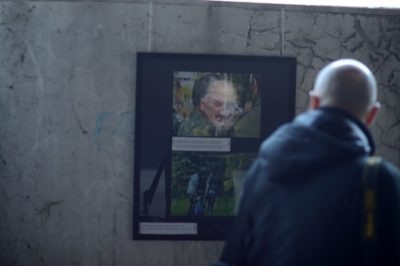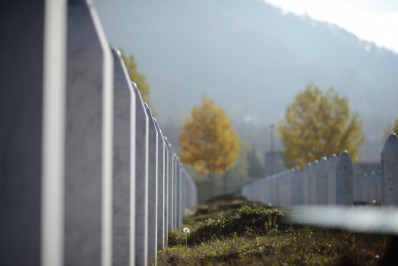We arrived in Srebrenica from Belgrade by night. At night the town looks like any other Bosnian town, enveloped in darkness, surrounded by hills now repopulated by trees; those closer to the town centre were cut down for firewood during the war. The hills around Srebrenica are not very tall, but they have sudden drops. Only on the second day of our stay, the sun will shine to reveal the beauty of the hills, a certain mildness brought out by the pastels of the leaves at the calendar start of winter. The first thing Srebrenica brings to mind is the grey colour of buildings, streets, nature, and the unusual name of its suburb: Soloćuša. The greyness is comparable to the colour of the clouds hiding the sun and constricting the horizon. That was my gut feeling about this town, mixed in with the bitter taste of human defeat. I had been here a few times before, but this time for the longest stay, long enough to get to know its streets whose pre-war names were reinstated in 2004. I would go down Učina bašča and then further on down Reuf Selmanagić Crni Street. When Ratko Mladić entered the town, he ordered the sign with the name of this street be removed from the wall right away. The names of the streets are written out in Cyrillic and Latin script on blue metal plates. For the first time, I realised Srebrenica was a deserted town. As you walk by rows of houses, everywhere you look, you see extinguished chimneys. Windows uninhabited by light or human warmth. Srebrenica is as desolate as a provincial railway station. Its houses are tangible metaphors of loneliness. The only sound you can hear as you walk these streets is the babbling of a brook crowded in by houses on the steep slopes of the hills. So, for the first day, I observed the houses, they kept me company during my nighttime walks. Out on the concrete unfenced steps leading to the attic of the house by the road, someone left two quinces with shrivelled leaves. Srebrenica is a falling star, the title of Melika Salihbeg Bosnawi’s poem runs through my mind. You may see a light in a window here and there, clothes hanging out to dry, a cat taking up the sphinx pose to warm itself on a car bonnet, welcome surprises revealing that there is life here, that it is hidden in every tenth house. Before the war, Srebrenica was one of the wealthiest municipalities in BiH. Its population, according to the 1991 census, was 36,666. The locals estimate there are just over five thousand people living in Srebrenica today. Quite a few less than there are buried in Potočari.

The next day, we visited the Memorial Centre in Potočari. On behalf of the group of war veterans from Serbia and BiH, a wreath for the victims was laid down by Ljuban Volaš, a veteran of VRS, Novica Kostić, a veteran of the JNA from Serbia, and Narcis Mišanović, a veteran of the BiH Army from Sarajevo. It was a truly special moment of showing respect and honouring the victims of the Srebrenica genocide. With us were the mothers of Srebrenica who told the veterans their tragic life stories. Our curator, Amra Begić, who was a child when the genocide happened, recounted the chronology of the tragedy vividly, from the point of view of a witness. Once again it turns out that those who have felt the horror on their own skin are the ones to talk about it most convincingly.

Following the history lesson, we continued walking around the Memorial Centre. The usual procedure is to let visitor decide whether they want to walk around on their own or have a guide take them through the vast space populated by white tombstones. Then, on a path between the graves, I chanced upon an older woman who started telling me about her murdered children. Of everything she said, I remembered the sentence: “Children are not mushrooms.”
Glass Marbles
There are two basic colours in Potočari: the green of the grass and the white of the marble tombstones. Here and there, you see the colour of fresh earth as the tombstones are dug into it at the ends of recent mounds. Workers are drilling into the concrete blocks at the poles of the mound in order to cement in the tombstones so that the marble does not tilt and sink into the earth. The only contrast are the red leaves on a stout tree, they are the colour of a setting sun. In Potočari, I hid behind my camera lens. It allows you to stay invisible, to put up an emotional barrier. The lens captured the faces of the veterans as they spoke with the mothers of Srebrenica and as they listened to Amra Begić. The once severely wounded sat on chairs, their faces reflecting pain and sympathy for those that were killed. These are all grown, strong men, who had discharged their duties honourably in the war. Here, space has overpowered measurable time, it was lost among the thousands of marble tombstones. The time of the dead reigns supreme here, and it started on 11 July 1995.
At the hangar where the infamous Dutch battalion was stationed, we saw an exhibition of photographs depicting the chronology of the war in Srebrenica. Objects found in mass graves are exhibited in dark niches. I saw a silver cigarette case, reading glasses, and two glass marbles on a glass pane. Beneath the photograph and the biography, it said: “Two marbles that used to belong to Ismet Hasanović, found in 1996 with his body on the surface of the Kamenica mass grave, Bratunac.” Is there a need to explain the frailty of child’s play, the flash of light trapped in a geometric figure, pulsating with life, an exotic microcosm you could escape into right before the moment of your execution in a field.
The Crown of the Crime
After seeing a documentary about the killing of the people of Srebrenica, the war veterans were most deeply touched by the testimonies of mothers who had lost their families in July 1995. “The reactions of the mothers tell us we are on the right track, that we should go on,” were the words of Narcis Mišanović, a veteran of the BiH Army, when he spoke to the press in Potočari. We then withdrew to the Misirlije hotel where everyone talked about his impressions from the visit to the Memorial Centre.
Đoko Pupčević, a member of the VRS from Šamac, summed up his thoughts thus: “Emotionally, it was a difficult day. I knew quite a bit about Srebrenica beforehand, but when you come here and see 8000 graves, tombstones, you see that life is nothing. The dead outnumber the living in Srebrenica today. I did not see a single child or smile. The streets are deserted, and it’s not a working day. I came to honour the innocent people killed here, killed only because they belonged to a different religion.”
Novica Kostić from Vlasotinac in Serbia, a JNA veteran from 1991 in Croatia, an amputee, missing fingers on his hand and with a wound on his “healthy” leg, said, “Srebrenica is a sacred place. It’s not just genocide that happened in Srebrenica, Srebrenica is the crown of the crime.”

Ljuban Volaš, a member of the VRS from Prnjavor, told me he had visited Potočari twice before. Once, he just looked through the fence, the second time, he entered into the Memorial Centre to look around, but did not venture among the graves. “As a man, I stand against crimes. The unit under my command did not commit crimes. It was an honour to lay down flowers for the victims of Srebrenica. I felt the pain and bitterness of mothers who bear it to this day. We must also see the other side, the Serb side, because there were crimes there, too. That is the only way to get a complete picture of the tragedy in BiH,” Ljuban concluded. The initiative to honour the victims of the Srebrenica genocide was supported by our hosts from Srebrenica: Amir Mehmedović Gera from the Patriotic League, Nedžib Delić, President of the Disabled War Veterans Association, and Nedžad Bektić from the Golden Lilies Association of the highest war medal bearers. We parted with them at the main intersection in Srebrenica, posing for a joint photo. The next time I come here, I don’t think I’ll feel like a stranger. Perhaps Srebrenica is the town from which we can start the process of genuine reconciliation among people in BiH. And perhaps that’s just my textual illusion. One thing I know: this town has become part of my conscious. It has settled itself deep within where shells and fires cannot reach it.
The article is, in a shortened version, published in bh magazine “Dani” 23rd November 2012